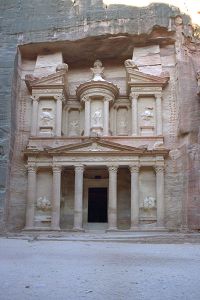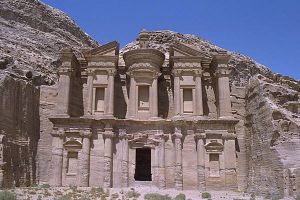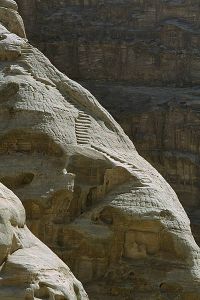PETRA NEW YEAR 1994 - day 2
text by Pink Oboe, pictures from Angus McIntyre's Petra Site. Includes dozens of beautiful images and a clickable map of the city.
preamble - day 1 - day 2 - day 3
Day two started early with yoghurt and buns. By eight o'clock we were ready with the whole motley crew of our party assembled outside the hotel. There were 39 of us varying in age between 25 and 87. They were a joy because everyone was there because they were interested in archaeology. Strangely enough not many lager louts are!
Bassem did a head count and led us off down to the direction of the entrance to Petra proper where we had gone the previous day. We walked in an untidy gaggle down the track pausing for explanations and examination of the monuments on the way. Bassem took us into a family tomb near the Obelisk monument. There were deep internal trenches which held the bodies. A snake and a rider on a horse carved in the rock decorated the interior.
We entered the Siq. If yesterday was busy then today was total bedlam. It was Saturday, which is their Holy day so the world and his wife were about. Horses, carts and a constant flow of people made the Siq into a main road. Bassem explained about the various features on the way down the Siq, the God Blocks drawn or carved on the walls, the votive niches, the raised pavements and throughout the amazing water engineering of the Nabateans.
 Today, a little earlier than the day before, we arrived at the bottom of the Siq to
find the sun upon the Khasneh. It glowed pink and seemed to swim in mist when viewed from the dark of a
recently excavated tomb opposite. We walked on down the misleadingly named Outer Siq which leads on
from the Siq (i.e. it is the Inner Siq but do not tell the Bedouin). Ancient Nabatean tombs front the
sides of the narrow gorge, narrow but not as narrow as the Siq proper. We pause inside a house/rock
tomb with the most exquisite banded sandstone interior. A woman and her baby sat inside selling
trinkets.
Today, a little earlier than the day before, we arrived at the bottom of the Siq to
find the sun upon the Khasneh. It glowed pink and seemed to swim in mist when viewed from the dark of a
recently excavated tomb opposite. We walked on down the misleadingly named Outer Siq which leads on
from the Siq (i.e. it is the Inner Siq but do not tell the Bedouin). Ancient Nabatean tombs front the
sides of the narrow gorge, narrow but not as narrow as the Siq proper. We pause inside a house/rock
tomb with the most exquisite banded sandstone interior. A woman and her baby sat inside selling
trinkets.
On to take mint tea from a cultured Bedouin who is married to a New Zealand lady. She came to visit about fifteen years ago and stayed to marry and raise a family. He told us that he has been to New Zealand twice and was going again in April. We bought more postcards, paid our half dinars for the refreshing tea and continued.
Then across the track to the Roman Theatre capable of holding 3,000 people. Bassem worked hard with explanations and dates to his captive audience. We walked onwards into a wide open area of gently rolling hills. This is where the main city had been, a city of 50,000 souls. Earthquake after earthquake had devastated the stone built buildings and little remains except for dust, stones and pottery shards by the million.
We walked down the beginning of the Colonnade Street and paused at the Nymphaem which once must have looked a little like the Trevi fountain. A 300 year pistachio tree grows there now and was glowing gold in the sunshine. The main Roman road, much of it still paved, led down past columns to a triumphal gate.
We had ordered our lunches while we had drunk our mint tea. The lunches awaited us at a café, which was a cave with an outstretched awning: pitta bread with sausage, pitta bread with cheese, a mini-cucumber and a tomato each. Also a very Arab looking yoghurt, which in fact came from Denmark! We eventually got Sage tea which we ordered early and got late through the intervention of a group of Germans. They had obviously got their towels there early. I paid the bill, which was five and a half dinars with roughly one dinar to the pound. Not bad for two packed lunches with drinks.
I sat beneath the awning after lunch and wrote the following:
"Lunch beneath an awning near the Kasr El Bint. Looking out I can see a donkey making its way laboriously up a path opposite. Green trees, eucalyptus, pistachio and citrus brighten the area. The aroma of sage tea, sweet and warm, providing the sensation of drinking turkey stuffing. The red sandstone lays in bands across my field of view. Carved temples and tombs are visible high on the hillside."
After lunch I climbed to the museum, took several photographs, signed the visitor's book then rendezvoused with the rest of the group. We were off to El Deir, otherwise known as the Monastery. Most of the well known monuments have names given them by the Bedouin to whom everything was either associated with the white prophet, Moses or the black, Pharaoh.
 The way up to El Deir
led up hundreds of steps through the most amazing coloured rocks. Up and up, losing very few of the old
and the unfit on the way. They paused to admire the scenery and await our return. On the way up we
passed multi-coloured patterns swirled by water under the Red Sea to make sandstone. Finally to a view
down a precipitous cut that had the vertigo sufferers huddled against the rock opposite. Suddenly we
burst out into a plateau where El Deir was carved from half a mountain. It was enormous with obvious
overtones of El Khasneh but on an apparently larger scale. We paused outside the inevitable cave café
and drank our 7 Up, which at half a dinar a bottle was extremely good value considering the distance
that it had been hauled.
The way up to El Deir
led up hundreds of steps through the most amazing coloured rocks. Up and up, losing very few of the old
and the unfit on the way. They paused to admire the scenery and await our return. On the way up we
passed multi-coloured patterns swirled by water under the Red Sea to make sandstone. Finally to a view
down a precipitous cut that had the vertigo sufferers huddled against the rock opposite. Suddenly we
burst out into a plateau where El Deir was carved from half a mountain. It was enormous with obvious
overtones of El Khasneh but on an apparently larger scale. We paused outside the inevitable cave café
and drank our 7 Up, which at half a dinar a bottle was extremely good value considering the distance
that it had been hauled.
 The weather remained bright and sunny. We inspected a succession of
cisterns that supplied the monks because the Monastery was actually used as such during the Byzantine
period of Petra's existence. One was still full from recent rain. Then it was down the route
that we had come, picking up the overweight and the down-hearted on the way. Rosemary helped Nora, a
splendid Colonel's wife who was the epitome of stiff upper lip, who had turned her ankle rather nastily
on the ascent and needed company and moral support on the way down. We staggered slowly to the horses
at the bottom end of the Outer Siq and rode majestically up the whole length of the return to end a
second perfect day.
The weather remained bright and sunny. We inspected a succession of
cisterns that supplied the monks because the Monastery was actually used as such during the Byzantine
period of Petra's existence. One was still full from recent rain. Then it was down the route
that we had come, picking up the overweight and the down-hearted on the way. Rosemary helped Nora, a
splendid Colonel's wife who was the epitome of stiff upper lip, who had turned her ankle rather nastily
on the ascent and needed company and moral support on the way down. We staggered slowly to the horses
at the bottom end of the Outer Siq and rode majestically up the whole length of the return to end a
second perfect day.



